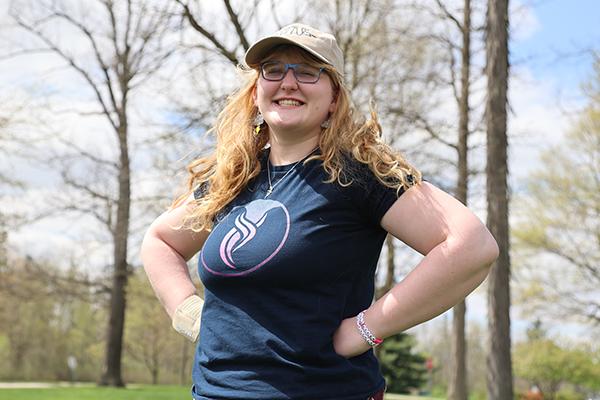When Lacilynn Graham’s dad let his toddler watch a special-effects-fueled blockbuster, he couldn’t have guessed where it would lead.
“I’ve always loved the weather. It started with my dad letting me watch Twister when I was three years old and he didn’t know what he did by letting me do that,” Graham said.
She started recording the weather around her and soaking in everything she could about storms. Her high school graduation present was a storm chasing trip. When it came time to choose a future path, meteorology landed at the top of the list, fulfilling Lacilynn’s interest in the weather and her parents’ interest in longterm stability.
Lacilynn met the aviation teacher at one of her first events at Ohio State Lima. When he found out about her lifelong interest in weather and meteorology, he encouraged her to sign up for the aviation class coming in her second semester.
“I've always thought being a pilot would be cool. I don't think I realized how much I liked planes until I took the class,” she said.
Exploring her interest in planes led her to switch her double major to meteorology and aviation. She hopes to combine the two as an aviation meteorologist, the field responsible for keeping planes and their passengers out of the way of severe weather and dangerous conditions.
Protecting others from the variables of weather has become a theme for Lacilynn. She is a certified HAM radio operator working to bring back Skywarn to our area, is CPR and first aid trained and is also training to be an EMT.
She earned the 2022 Paul Samaras Scholarship from the National Storm Chaser Summit and presented at the 2023 conference about the connection between storm chasing, disaster relief and mental health. Her scholarship is named for one the first three storm chasers known to be killed in a storm, in this case the 2013 El Reno tornado in Oklahoma.
While meeting many of her idols in the field was exhilarating, all the Grahams want Lacilynn’s feet to remain firmly on the ground, quite literally.
Lacilynn and her dad made the trip to Mayfield, Kentucky, following the December 2021 E4 storm to help with the cleanup. Both wanted to help the survivors and her dad wanted her to get a good look at the other end of a storm. Between the destruction and human devastation, it was difficult to take in.
“You really get a gut punch of what a tornado can do. I think that'll help to know that if I see a storm that I feel is too strong, I need to get out of the way. Or if it starts doing all types of things like turns or if it starts growing rapidly, I need to be able to keep an eye on that along with my surroundings. I need to have exit plans.”
While the site of what a tornado can do was sobering, it didn’t deter Lacilynn from her interest in storm chasing. She wants to use her knowledge and experiences to help keep others out of the paths of storms. She is already a certified storm spotter for the National Weather Service, able to identify the different weather and cloud formats.
“When I see something, I report that to the National Weather Service to help make sure that people in the line know where the tornado is, know which way it's moving, how far away from a populated area it might be. That way that the National Weather Service knows so then they can push out the warnings to more people.”
Another aspect of being a spotter is reporting damage after storms to help determine the category of storm. Ironically, Lacilynn had to call in damage to three sheds at her own house when tornadoes went through Allen County in March 2023.
“We saw the carport get lifted up in the air and then we were like, you know, it's basement time,” Lacilynn said. “After that we assessed our damage and called it into the National Weather Service and the news channel here so that they could put out the warning and let people know that there was an actual tornado and then we went around the neighborhood to make sure that our neighbors were okay.”
According to Lacilynn, our area of the state falls into a radar hole between three different weather centers which puts the weather forecasters tasked with keeping the pubic informed at a disadvantage. Graham has started a letter-writing campaign to add a radar station in northwest Ohio.
“Being a spotter is so much more important in an area like this part of Ohio,” she said.
Lacilynn hopes to spot a different kind of storm this year as well, one not found in Ohio. In addition to her and her dad’s goal of seeing three visible tornadoes and getting some great lightning shots with his new camera, she has added spotting from inside the eye of a hurricane. And because he is a good dad, he’ll probably go.
